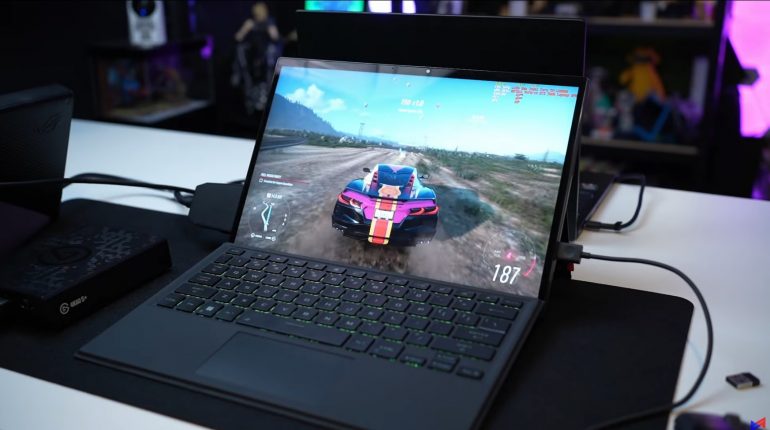INTRODUCTION
Last year, ASUS launched the ROG Flow X13 gaming laptop which sparked interest among gamers and enthusiasts. It was basically a 360-degree ultrabook with gaming capabilities thanks to the ROG XG Mobile. A year after the release and we already have its successor, the ASUS ROG Flow Z13 which brings a whole new look and purpose compared to its predecessor. The ROG Flow Z13’s changes and improvements make it a Microsoft Surface Pro for gaming thanks to its more powerful hardware with the Intel 12th Generation core series processor and a new ROG XG Mobile external graphics featuring the Radeon RX 6850M XT.
ASUS ROG Flow Z13 Configurations
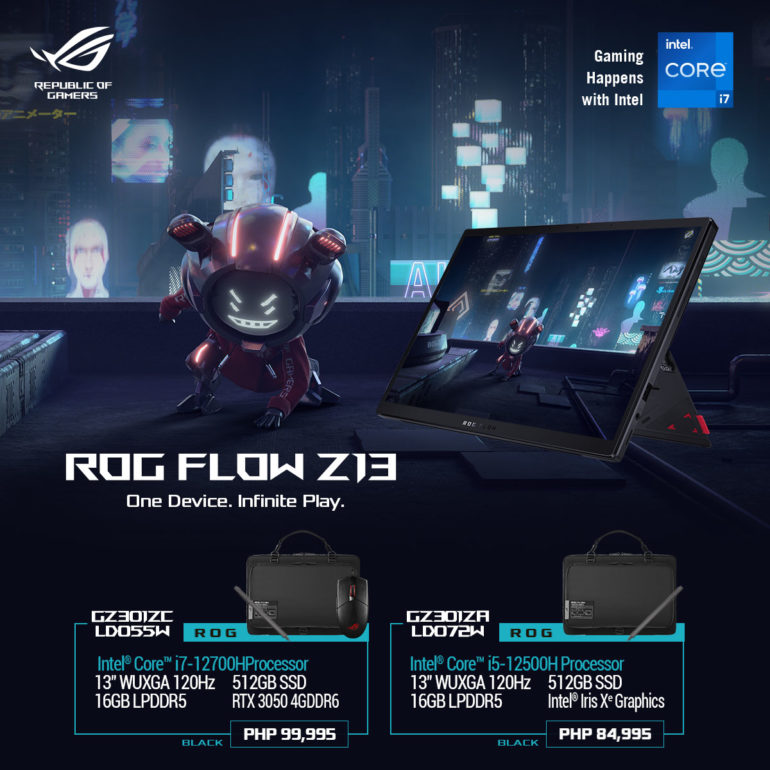
The ROG Flow Z13 is currently available in the Philippines in two configurations with the main difference being the processor. The Core i5 12500H variant retails for Php 84,995 while the i7 12700H configuration with an RTX 3050 is priced at Php 99,995. A Php 15,000 premium for an upgraded processor and a dedicated graphics card is actually a good deal, however, I find the 512GB SSD storage lacking for a device of this price range. Our specific review unit is the GZ301ZC-LD055W with the i712700H and dedicated GPU.
GC32L XG Mobile – RX 6850M XT Specs
| RX 6850M XT – XG Mobile | RX 6800 XT – DESKTOP | RX 6700 XT – Desktop | |
| Compute Units & Ray Accelerators | 40 | 72 | 40 |
| Stream Processors | 2560 | 4608 | 2560 |
| Power | 140-165W | 300 W | 230 W |
| Clocks | 2463 MHz | 2250 MHz | 2581 MHz |
| Memory | 12 GB GDDR6 | 16 GB GDDR6 | 12 GB GDDR6 |
| Memory BUS | 192 bit | 256 bit | 192 bit |
| Infinity cache | 96 MB | 128 MB | 96 |
Paired with our ASUS ROG Flow Z13 is the 2022 ROG XG Mobile external graphics which houses the newly announced AMD Radeon RX 6850M XT mobile graphics. Specs-wise, the RX 6850M is quite far from its desktop counterpart with almost no matching key spec. Specs-wise, the RX 6850M XT seems to be closer to the RX 6700 XT desktop GPU albeit in a lesser TGP and slightly lower clock speeds.
ASUS ROG Flow Z13 Unboxing and First Impressions
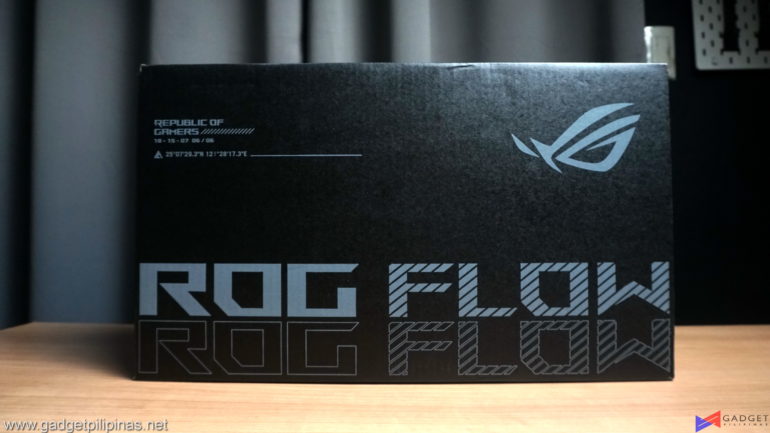
The ROG Flow Z13 comes in a uniquely designed box with the ROG Flow text printed in two styles. It’s common for ROG to make custom packaging for its special edition or niche laptops.
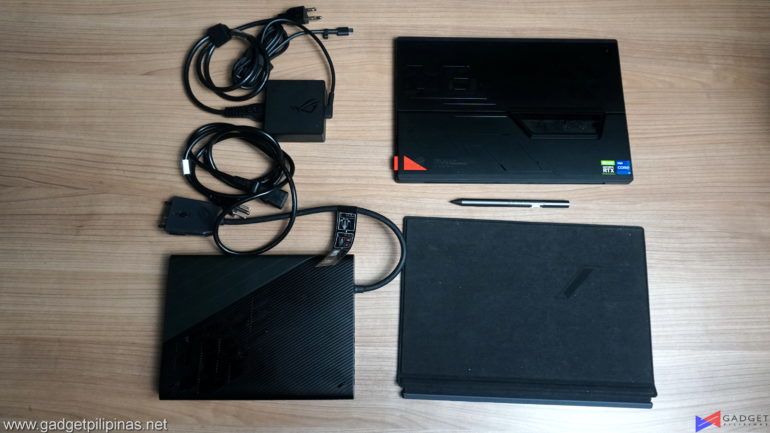
Contents of the packaging are as follows
- ASUS ROG Flow Z13
- 65W Type C Power Adapter
- ROG Flow Z13 Type Keyboard
- ROG Pen
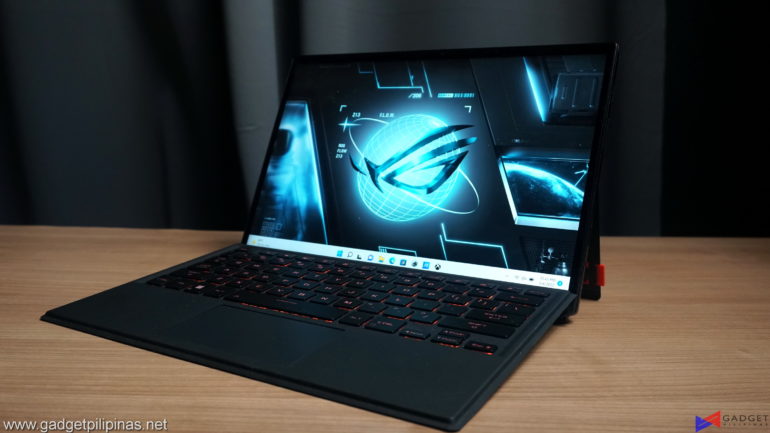
At first glance, the ROG Flow Z13 looks almost identical to the X13 predecessor mixed with Mircosoft surface elements thanks to its detachable keyboard.
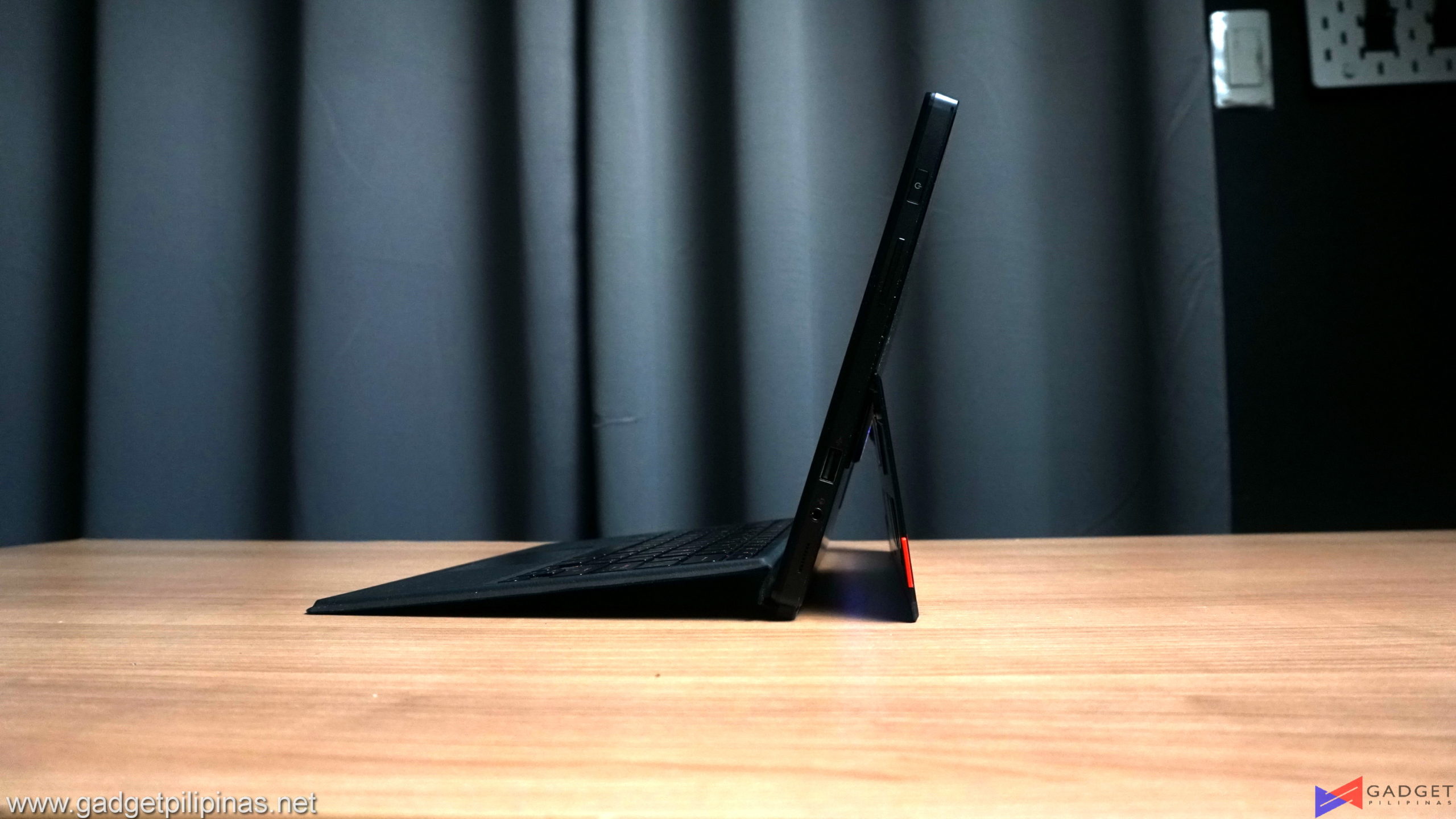
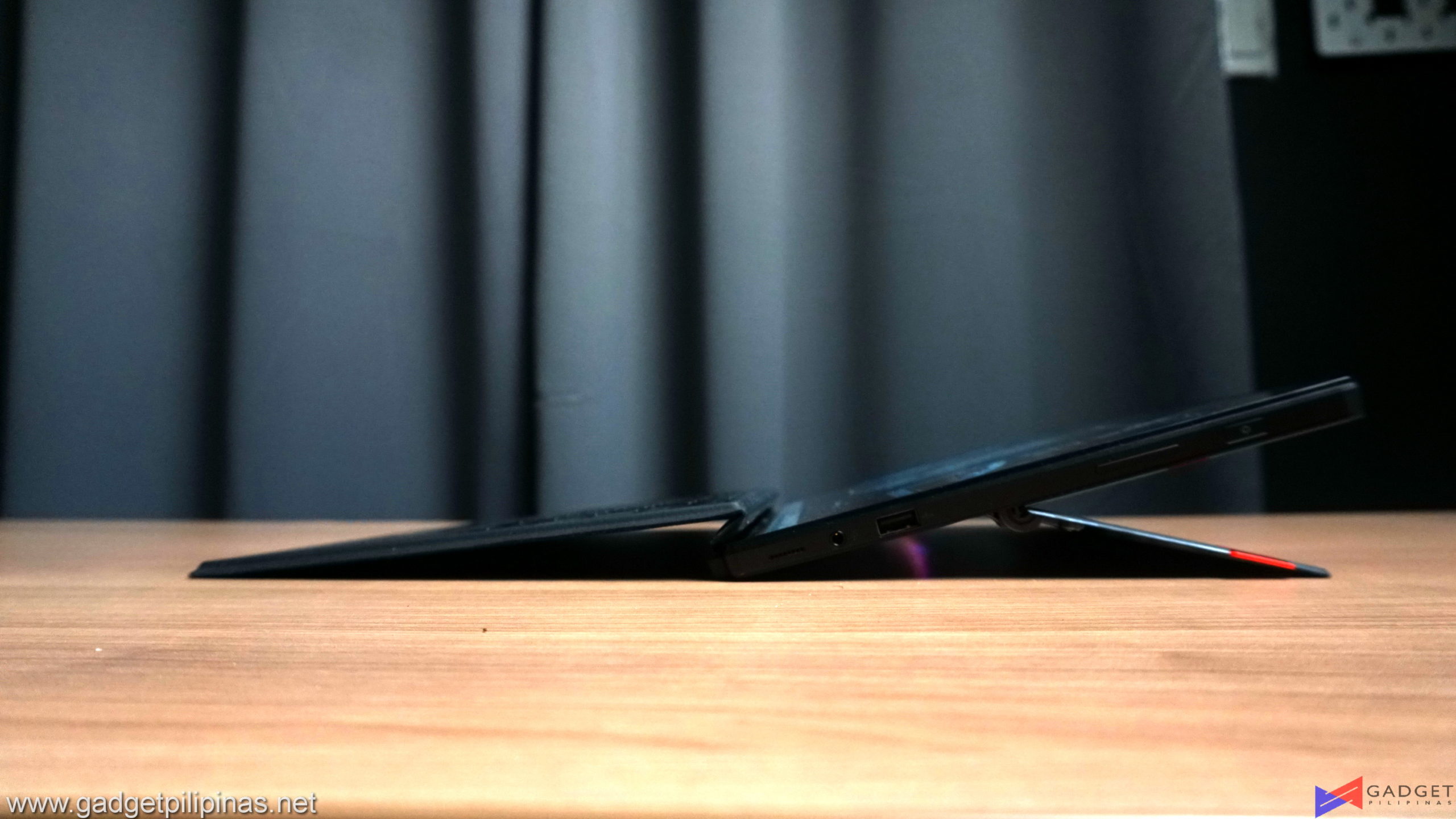
Having owned a Microsoft Surface Pro 8, the hinge on the ASUS ROG Flow offers more flexibility in terms of its angle elevation, allowing the user to adjust the screen as they see fit.
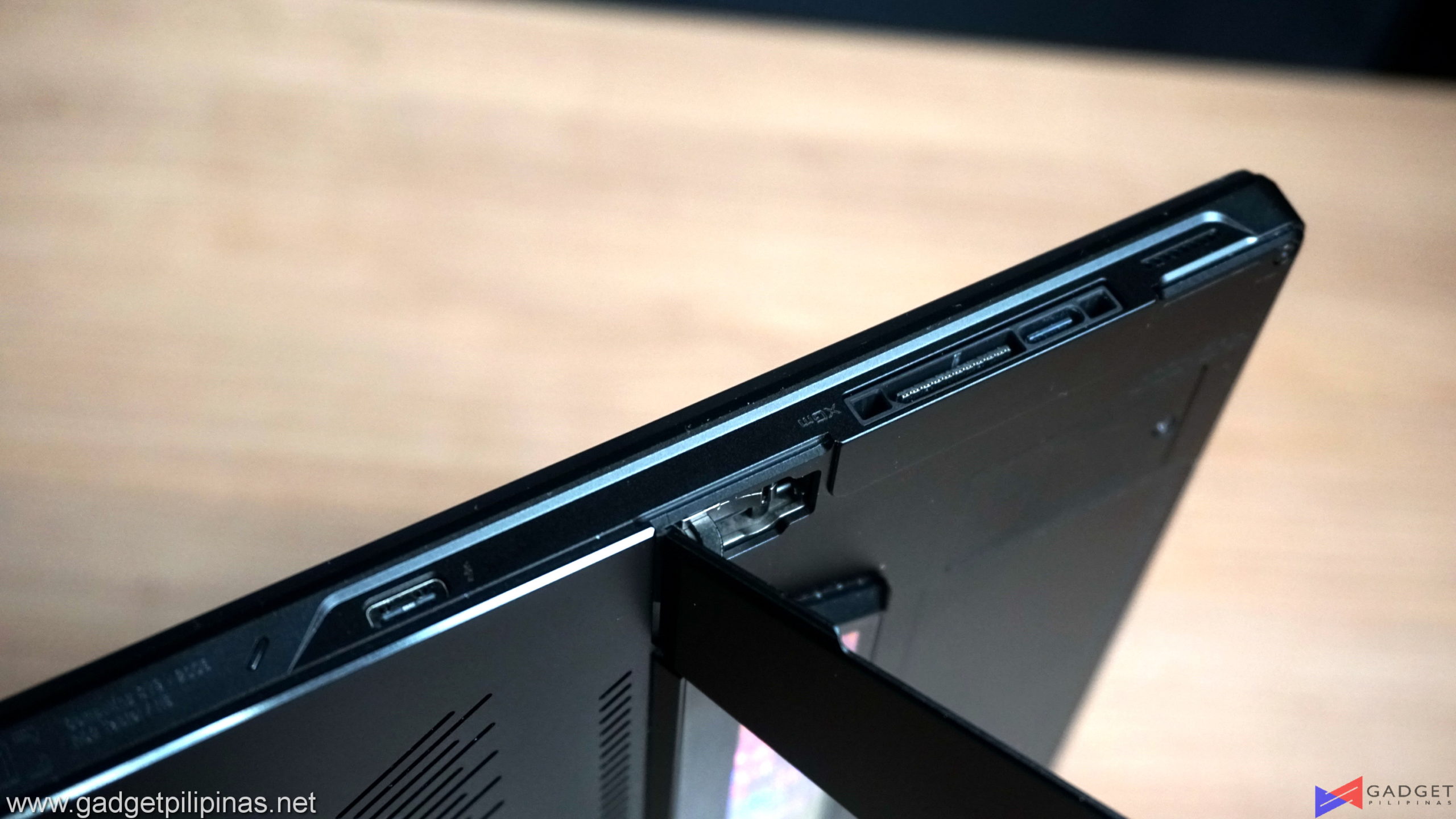

The hinge on the ROG Flow Z13 is noticeably sturdier and has a more advanced mechanism than the one found on the Surface Pro 8. Durability-wise, I don’t expect the hinge to fail throughout the lifespan of the ROG Flow Z13.
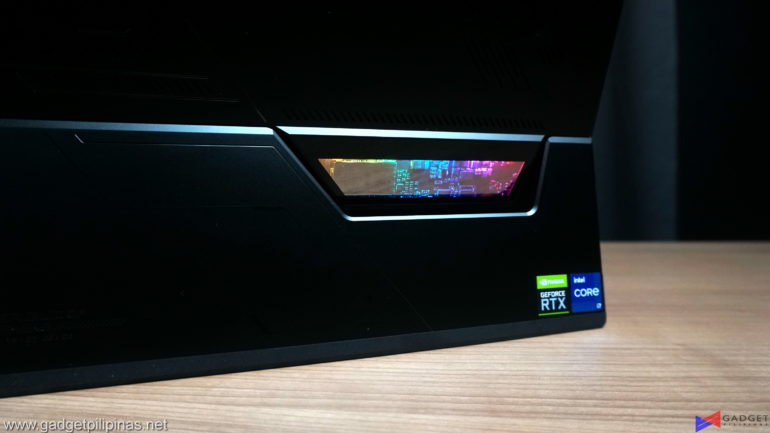
ASUS added a wonderful aesthetic to the ROG Flow Z13 with a glass cutout at the back of the Z13. The exposed PCB area has RGB lighting to give off that premium feel. However, the RGB PCB cutout gets harder to see as you bend the hinge above the usual 90-100 degree angle.
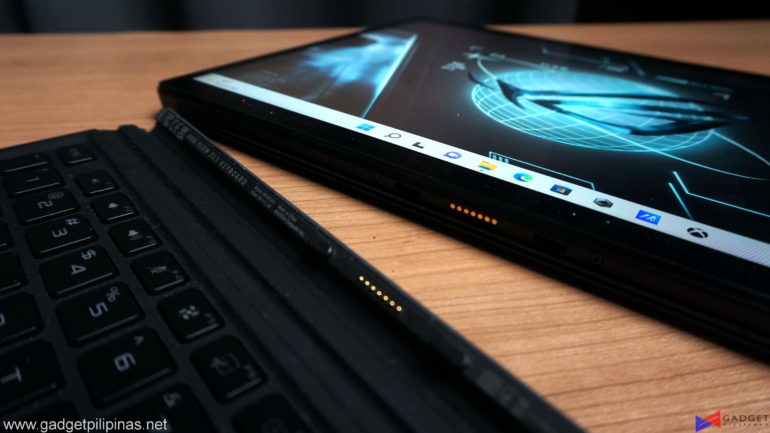
The detachable keyboard is held by powerful magnets at the bottom part of the ROG Flow Z13. Additionally, the keyboard uses a proprietary 7-pin connector so aftermarket keyboards and the surface type cover won’t be compatible with the ROG Flow Z13.
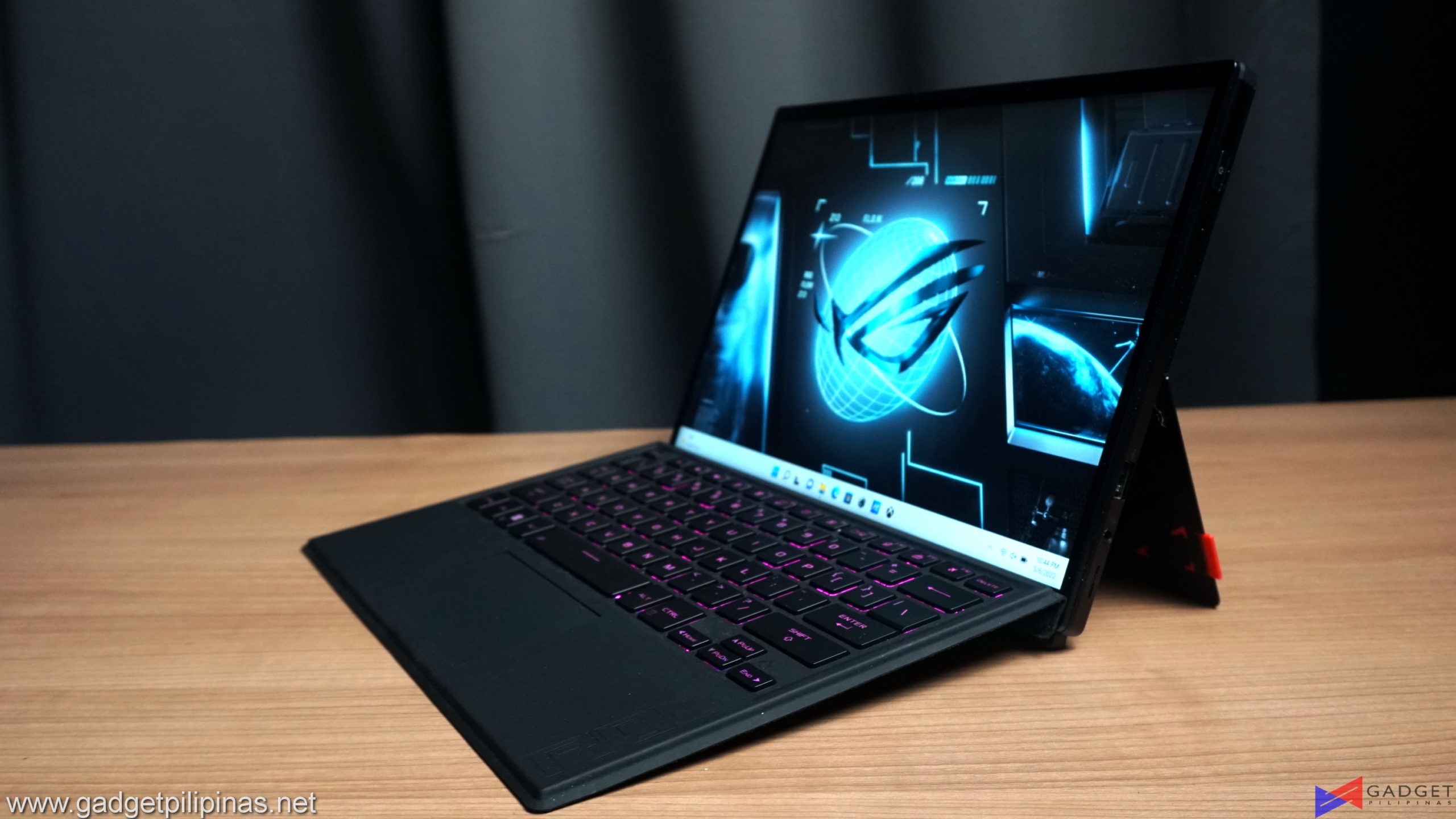
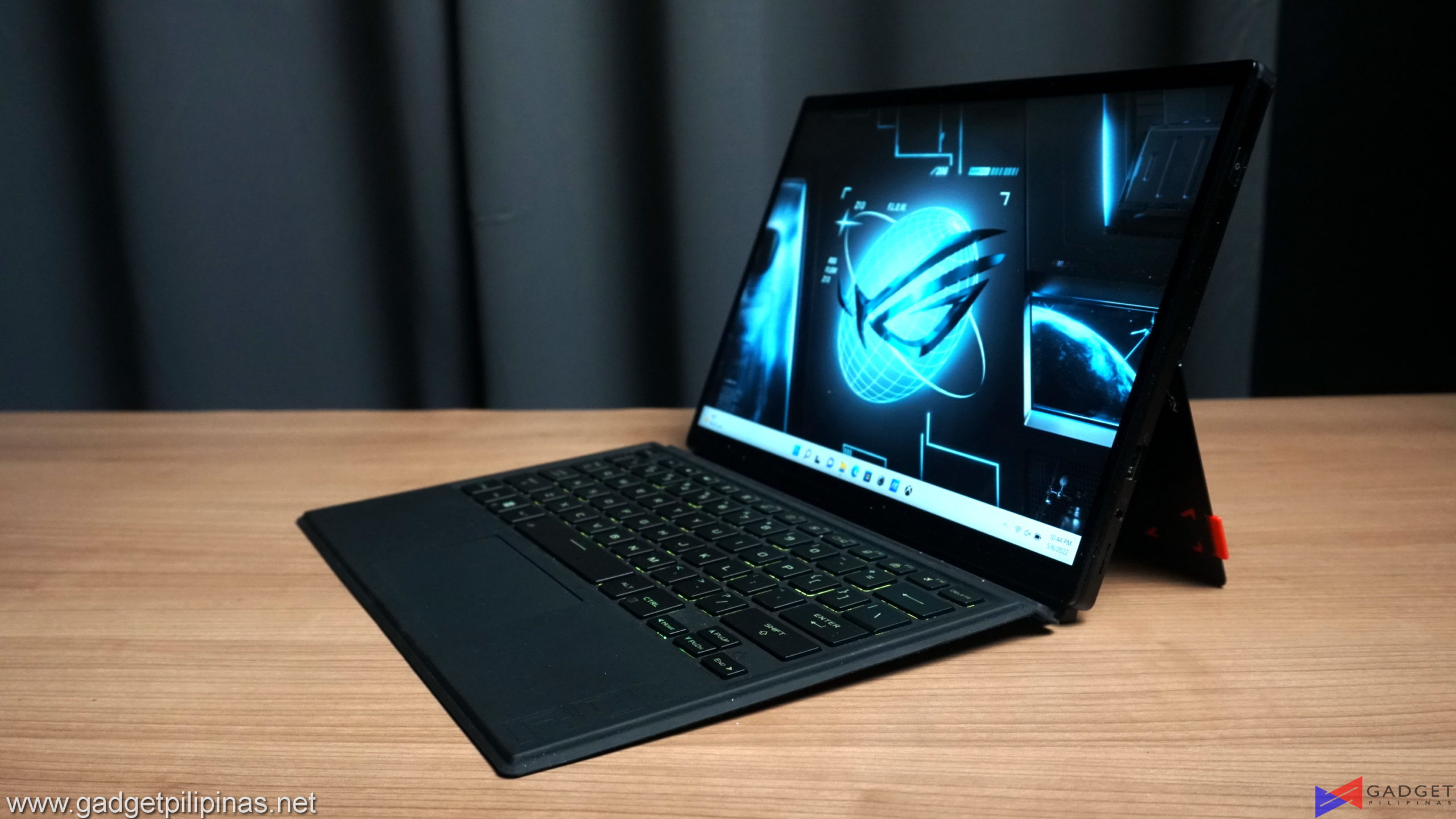
Like the Surface Pro type cover, the keyboard of the ROG Flow Z13 can be used either flat or elevated. We recommend using the keyboard at an elevated angle as it’s simply more stable versus the flat layout as the keyboard slightly wiggles as you type due to the unattached extra flap.
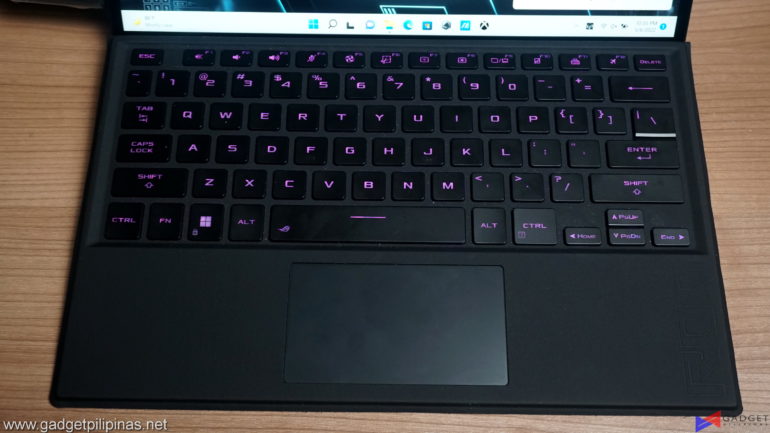
The typing experience on the ROG Flow Z13 is much better compared to the traditional ultrabooks. But compared to the Microsoft Surface type cover, the ROG Flow Z13 is leagues behind especially with its small trackpad which is questionable for the brand as their laptops have larger than standard trackpad sizes.
2022 ROG XG Mobile GC32L – RX 6850M XT
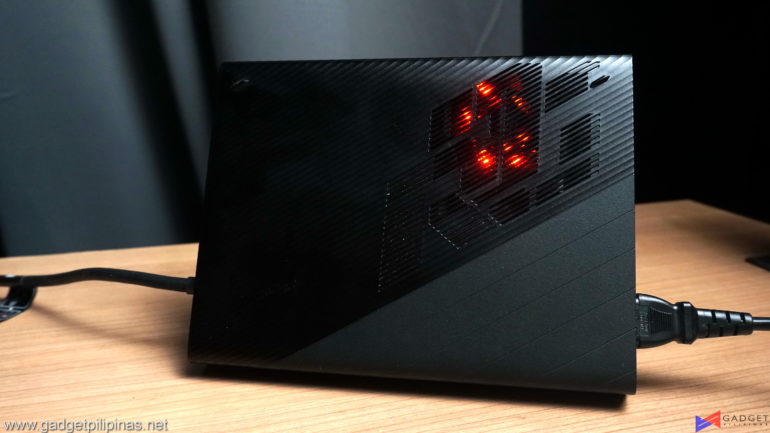
The ROG XG Mobile relaunches but this time with a different graphics card as this year’s iteration sports an AMD Radeon RX 6850M XT mobile graphic. While the RX 6850M XT uses much less power than the RTX 3080 XG Mobile, this year’s model is slightly thicker.
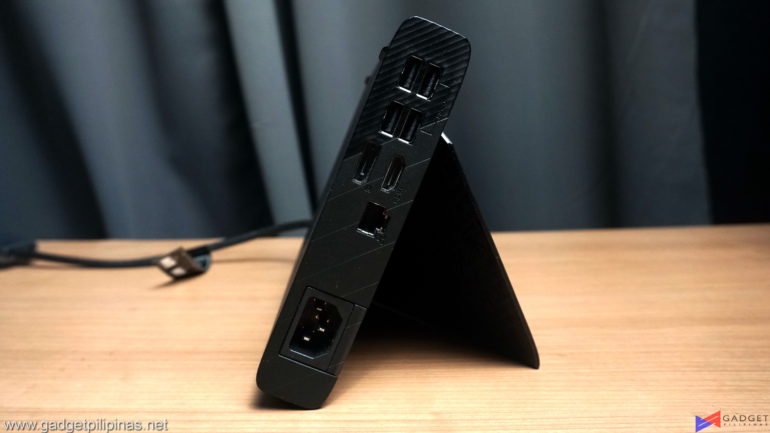
Despite the thicker body, the 2022 ROG XG Mobile retains the same amount of ports found on the RTX 3080 XG Mobile. The XG Mobile gives you four more USB 3.2 Gen 1 type-A ports, one HDMI 2.1 port, one DisplayPort 1.4a with GSync support, and one ethernet port.
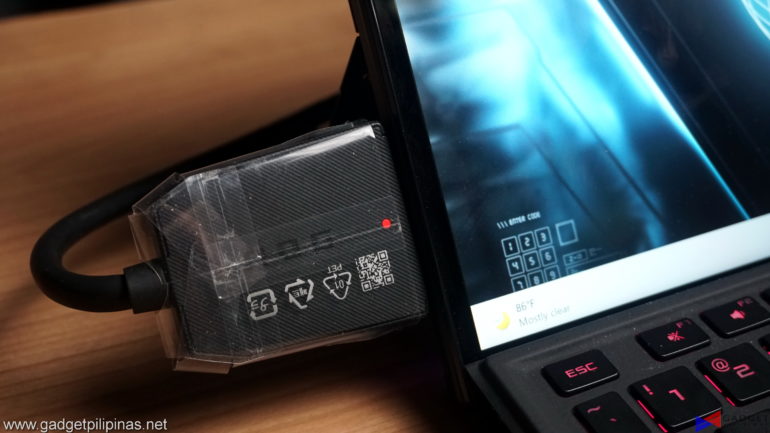
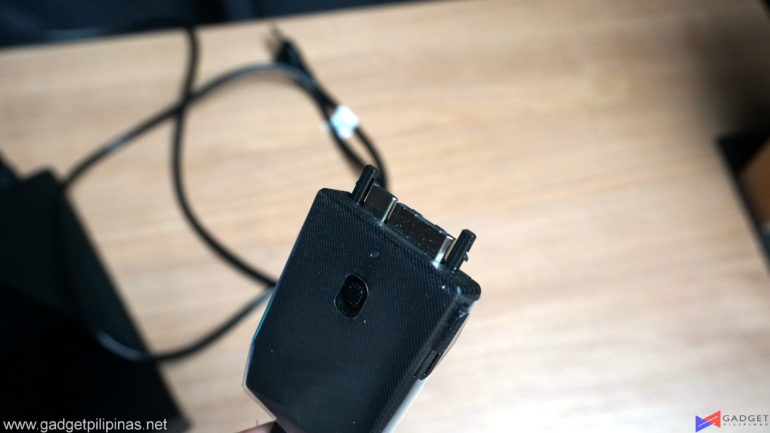
This year’s XG Mobile uses the same proprietary XG connect port which offers 8-lanes of PCIe compared to 4-lanes on Thunderbolt 4.
ASUS ROG Flow Z13 Display and Camera
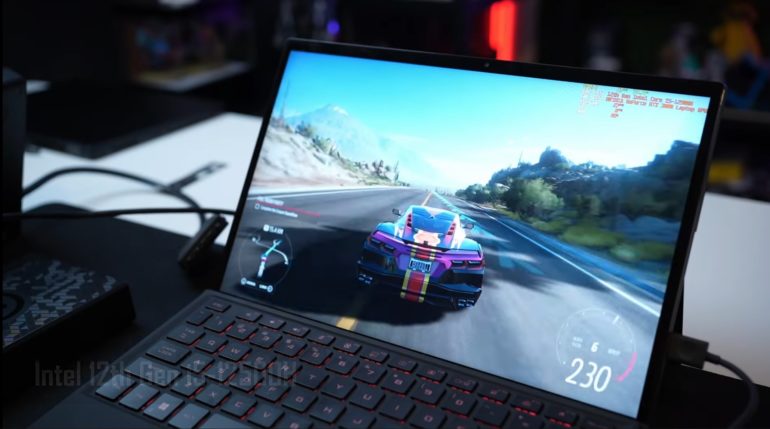
The display is a love-hate relationship in terms of resolution and color accuracy. At this size, I would’ve preferred a dense screen with at least a 1440p display to enjoy crisp visuals but choosing to go for the 1920x1200p route is understandable since the ROG Flow Z13 is built with gaming in mind. That said, the 13.4″ WUXGA 500-nit 16:10 display is simply a joy to use thanks to its 120Hz refresh rate and overall responsiveness.
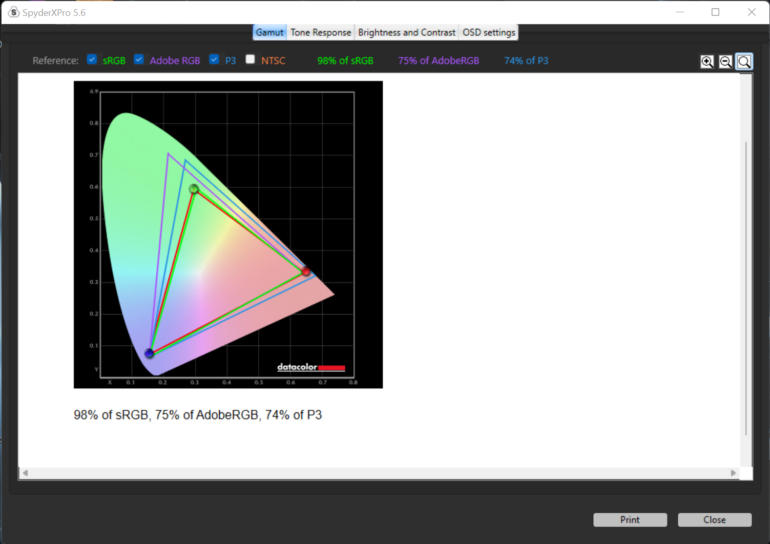
Color Accuracy-wise, the ROG Flow Z13’s display sits at above-average making it viable for professional-grade photo and video editing work as verified by our SpyderX Pro display analysis tool.
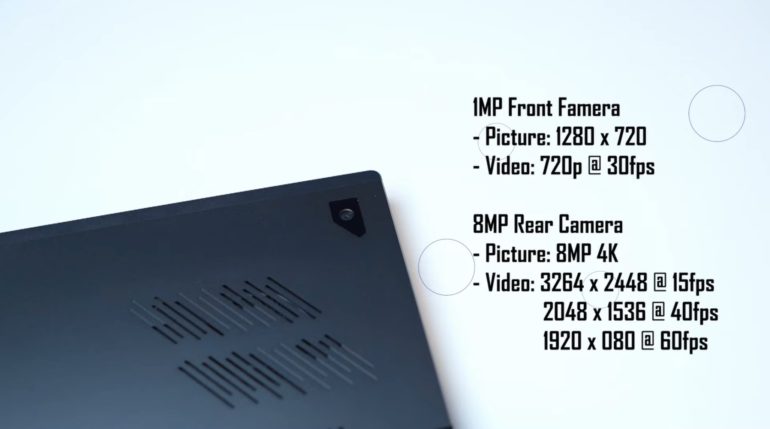
Being a tablet-convertible, ASUS had to pack two sets of camera on the ROG Flow Z13. The front camera is a 1MP 720p camera while the rear sports a much better 8MP 4K sensor.

Even with decent lighting, the 1MP isn’t as great and I would not recommend the ROG Flow Z13 for video conferences.

The same can be said with its 8MP camera as the color are somehow way off, so much that it makes the 1MP front camera look much better.
ASUS ROG Flow Z13 Software and Bloatware
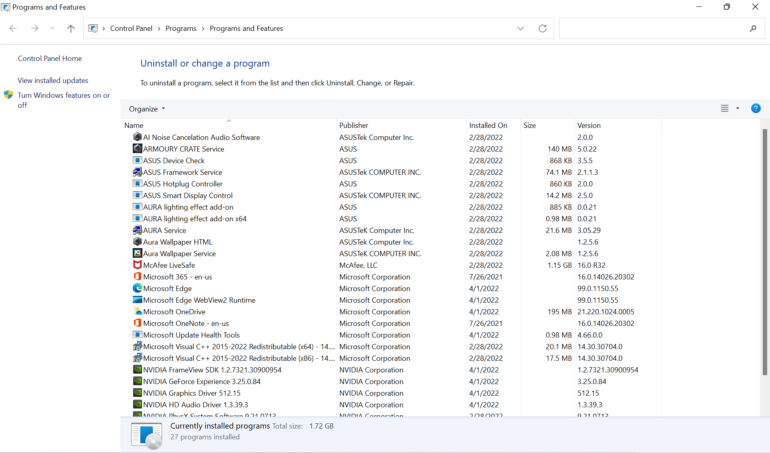
Without a doubt, the ROG Flow Z13 has one of most bloatware among the ASUS and ROG laptops launched in the last three years. The extra bloatware or arguably drivers are for the XG Mobile connect, external RGB and keyboard to make the Flow Z13 function properly.
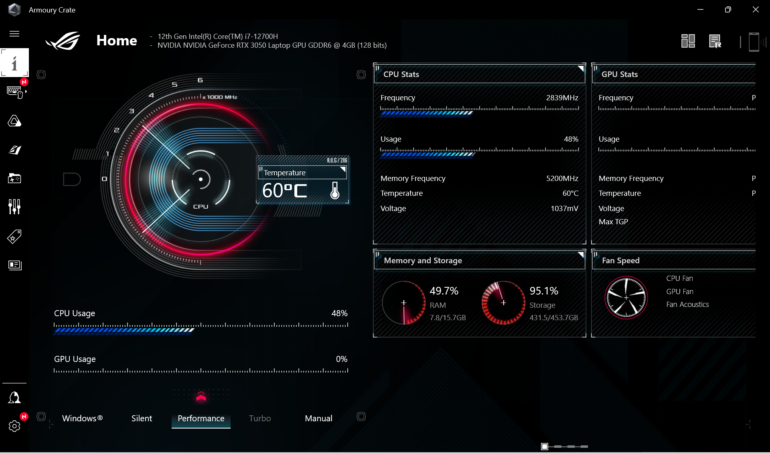
Armoury Crate lets your control everything on the ROG Flow Z13 from profiles all the way to fan speeds and RGB lighting. The new Armoury Crate look is much better compared to the gamer-y and ROG-themed armory crate software we’ve seen in the past. This version simply looks cleaner and easier to navigate and makes it feel like an essential software rather than bloatware.
ASUS ROG Flow Z13 Synthetic Benchmarks
SSD Benchmark
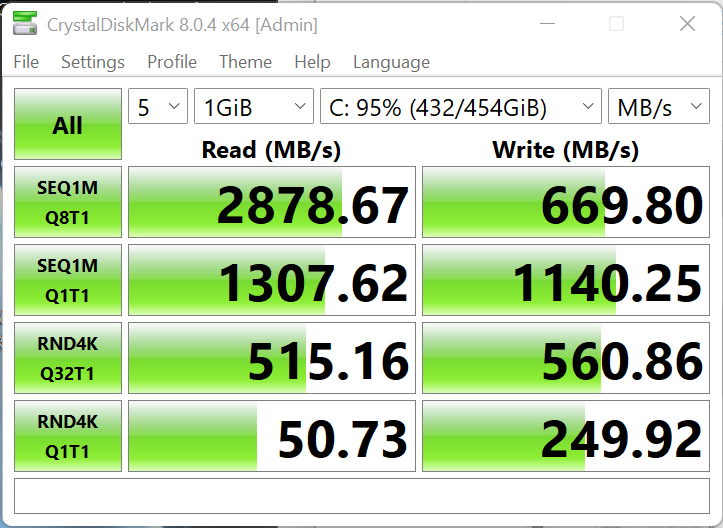
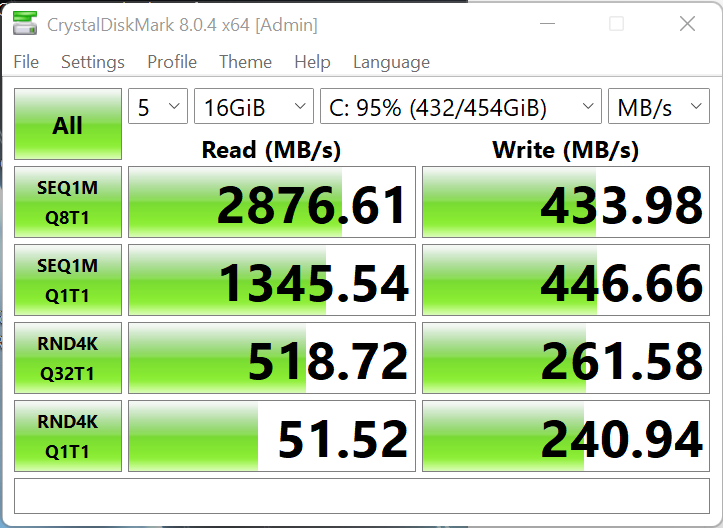
Developed by Noriyuki Miyazaki, CrytalDiskMark is a free benchmark tool that is being used by thousands of experts. This tool measures SSD’s sequential read and writes speeds. That means how fast files can be read from and written to the drive, usually measured in MB/s.
ASUS used Micron 2450 MTFDKBK512TFK 512GB SSD on the ROG Flow Z13. Despite using a PCIe Gen4 SSD, the SSD on the ROG Flow Z13 is more like a Gen3 SSD with its rated speeds of 3,500MB/s read and 3,000MB/s write. Unfortunately, its write speeds are downright disappointing as seen on our CrystalDiskMark tests. However, for a gaming tablet convertible, it’s on a passing mark thanks to its decent write speeds.
ASUS ROG Flow Z13 Benchmarks – RTX 3050 vs RX 6850M XT
We used CapFrameX Capture and Analysis Tool v1.6.6 to capture framerates for our benchmark run. We are using the latest AMD and Nvidia drivers for our benchmarks of the ROG Flow Z13. HWInfo64 and AIDA64 are both used to measure CPU and GPU temperatures.
3DMARK
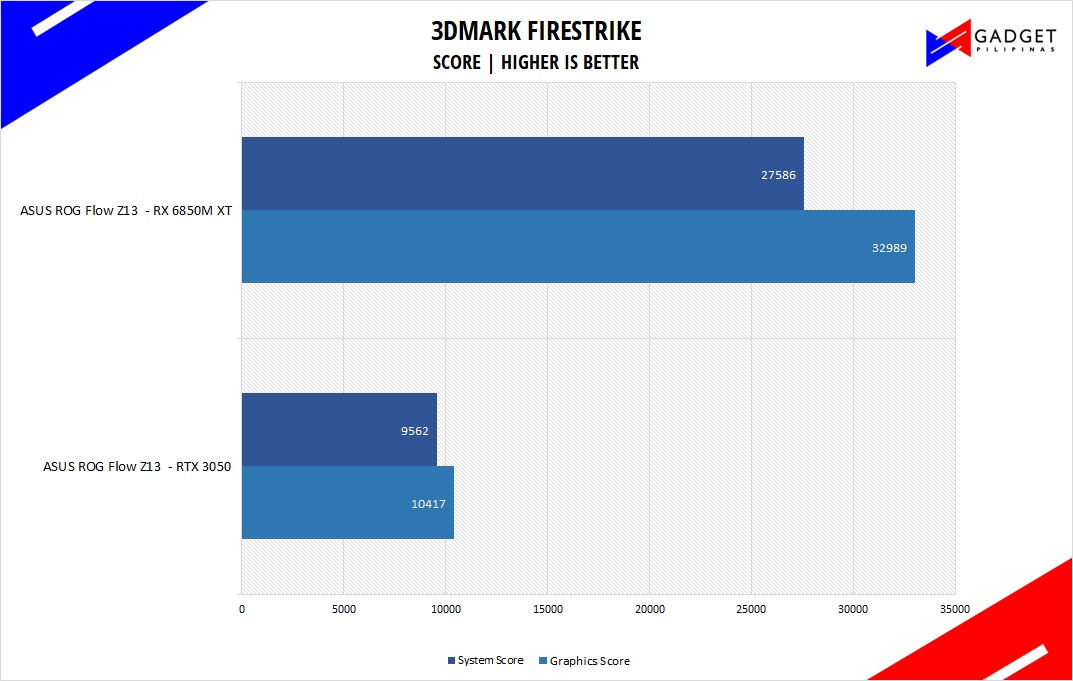

3DMark is the go-to benchmark for gamers because of the ability to share and compare results online. We tested the ROG Flow Z13 both in Fire Strike and Time Spy to get a good gauge of DX 11 and DX 12 API performance.
COUNTER-STRIKE: GLOBAL OFFENSIVE
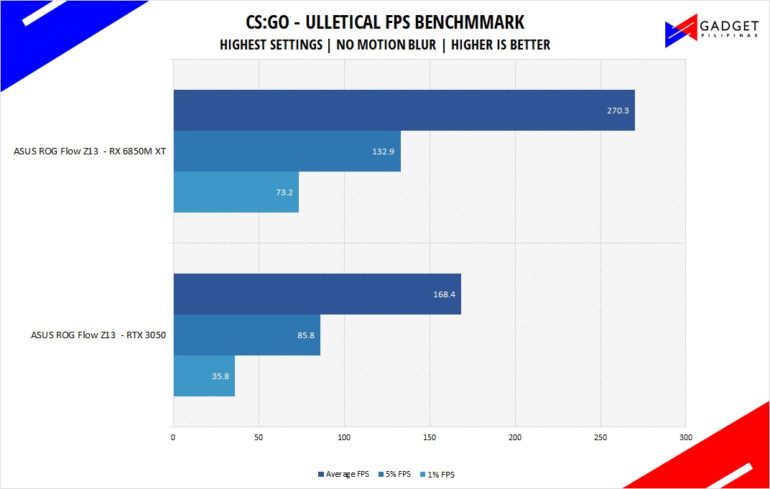
Counter-Strike Strike: Global Offensive aka CSGO is a 10-year old first-person shooter title that’s still widely popular despite its old Source Engine. CS:GO is a great game to test out CPU performance as the game is heavily CPU-dependent like any other FPS title. Our CS:GO benchmark process uses ULLETICAL’s FPS Benchmark workshop mod to measure the hardware’s performance.
DOTA 2
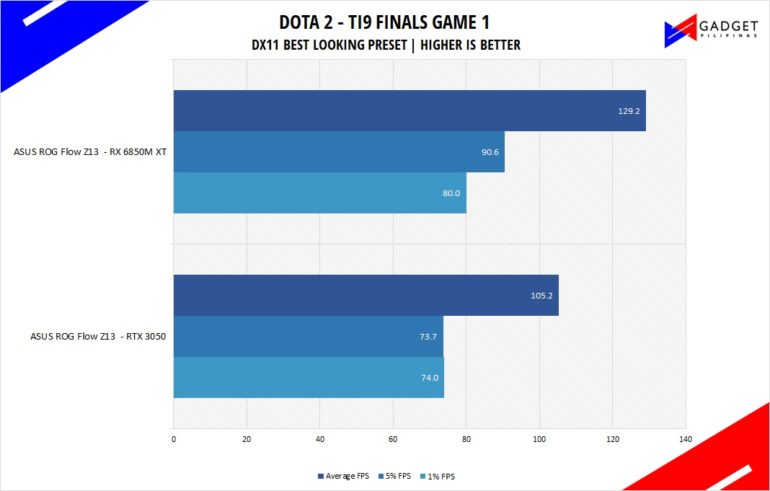
Most gamers play at least one of the following free-to-play titles: League of Legends, CS: GO, Dota 2, and/or Fortnite. Dota 2 is a good representation of the F2P titles as it is the most demanding game in the spectrum. The benchmark will give you an idea of the graphic card’s relative performance on other lesser demanding titles. Our benchmark sequence is based on a replay of OG vs. Liquid in the TI9 grand finals from the team fight that happened from 28:30 to 29:30.
Far Cry 5 & Far Cry 6
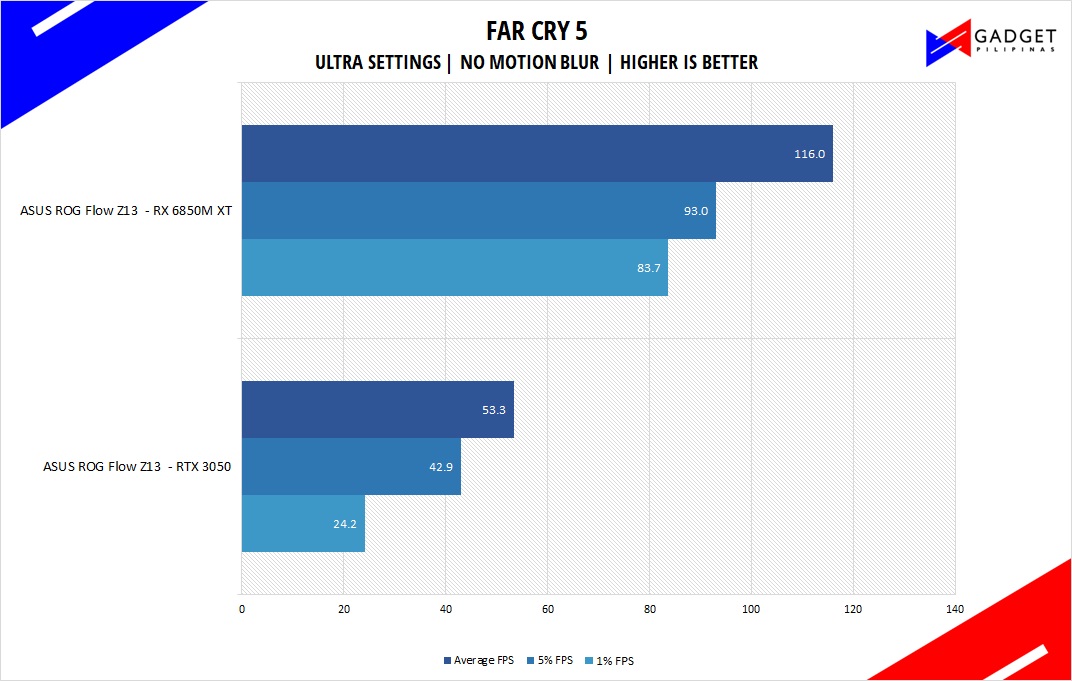
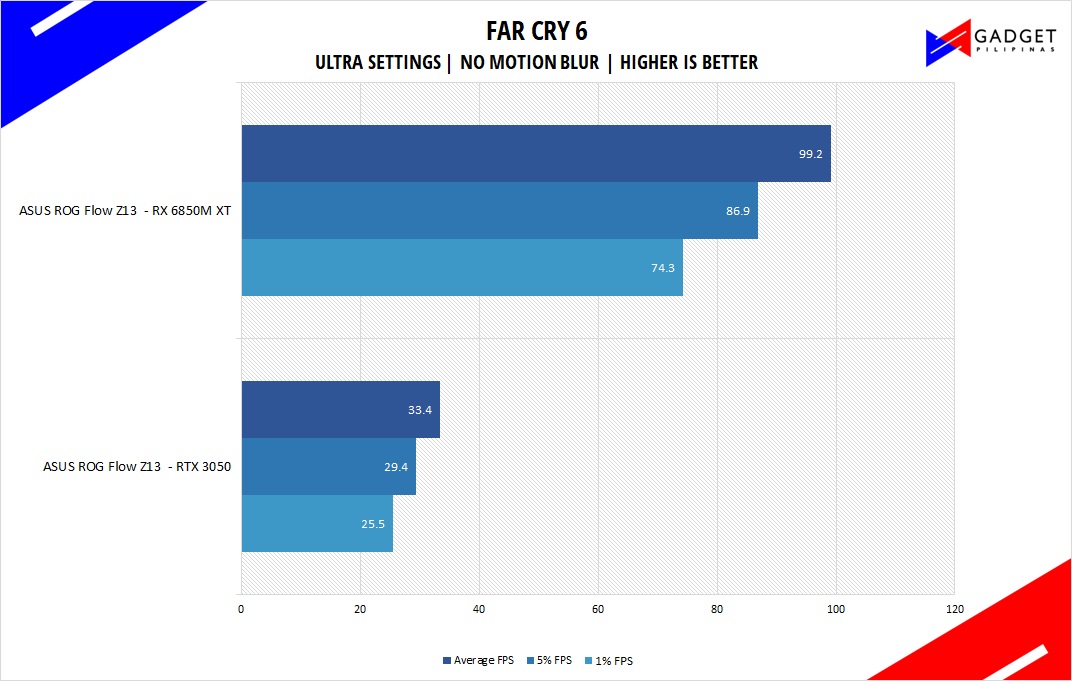
FarCry 5 is an FPS game published by Ubisoft and uses the Dunia engine. It heavily relies on and takes advantage of DirectX 11 to render a realistic environment that makes it taxing to both the CPU and GPU. Far Cry 6 is the latest installment in the franchise which utilizes DirectX 12 to run the virtual world of Yara.
Rainbow Six Siege
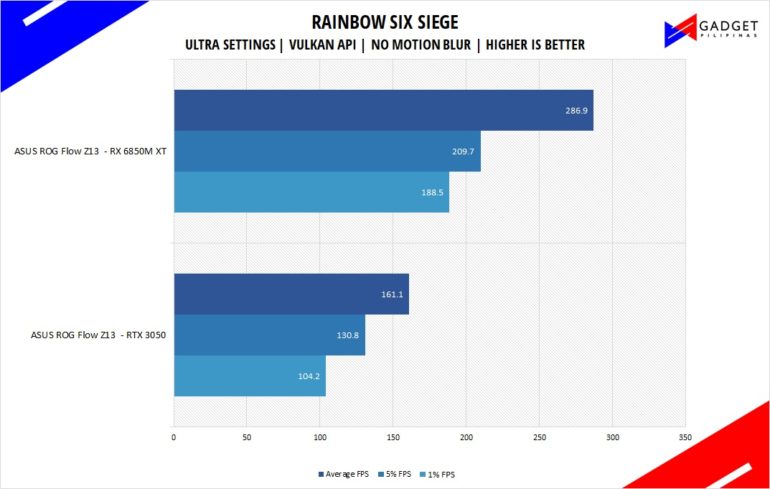
Rainbow Six Seige is one of the few popular AAA games that’s still popular in 2021 due to its competitive gameplay mechanics. R6S uses the AnvilNext game engine, which the game’s publisher, Ubisoft, developed. As of writing, Rainbow Six Siege is currently the most popular Tom Clancy title beating out Wildlands, Breakpoint, and even Division 2.
Cyberpunk 2077
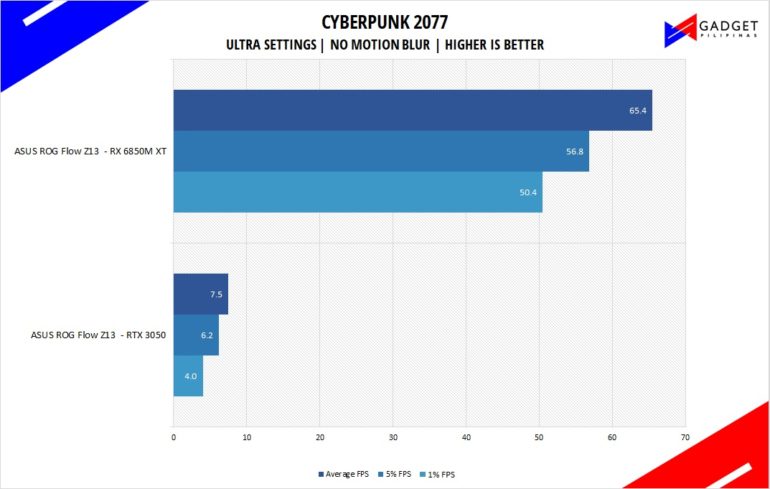
Cyberpunk 2077 is arguably the most hyped game of 2020. Developed by CD Projekt Red, the dystopian open-world, action-adventure RPG sports is one of the most demanding titles to date. Cyberpunk 2077 also supports three Ray Tracing settings as well as DLSS which makes the game a great tool to measure Ray tracing performance for both AMD and Nvidia graphics cards.
Shadow of The Tomb Raider
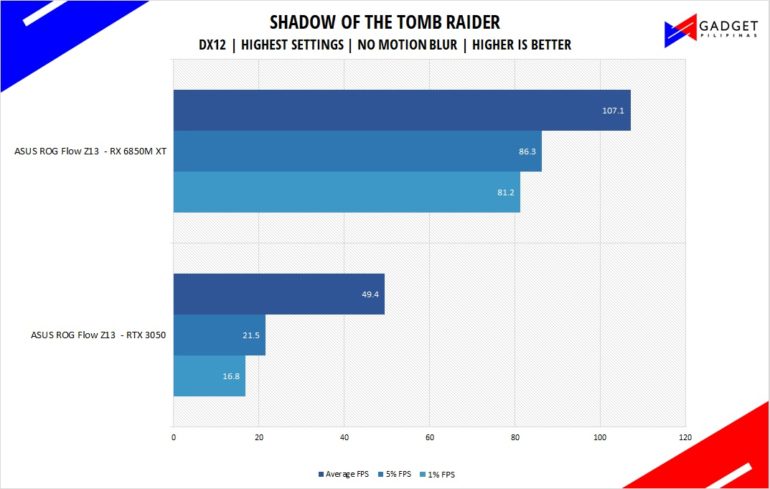
Shadow of The Tomb Raider or SOTR is the latest installment of the Lara Croft Tomb Raider franchise. Developed by Square Enix, SOTR uses the Foundation engine and is further enhanced by Eidos Montreal. SOTR is also one of the first games to come out with Ray Tracing and DLSS support.
Metro Exodus
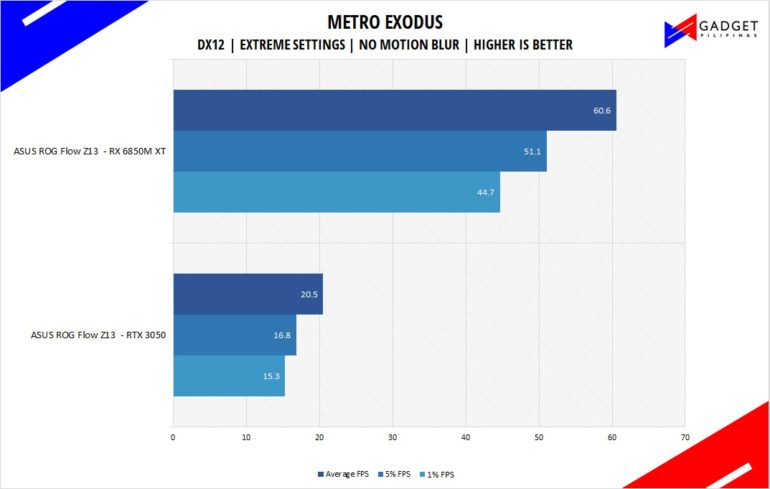
Metro Exodus is the third Metro game trilogy based on Dmitry Glukhovsky’s novels. The game is a first-person shooter with survival horror and stealth elements. The post-apocalyptic game uses 4A Engine by 4A games. Released last 2019, Metro Exodus remains to be one of the most graphically pleasing and demanding games that’s popular to date.
Assassin’s Creed: Odyssey
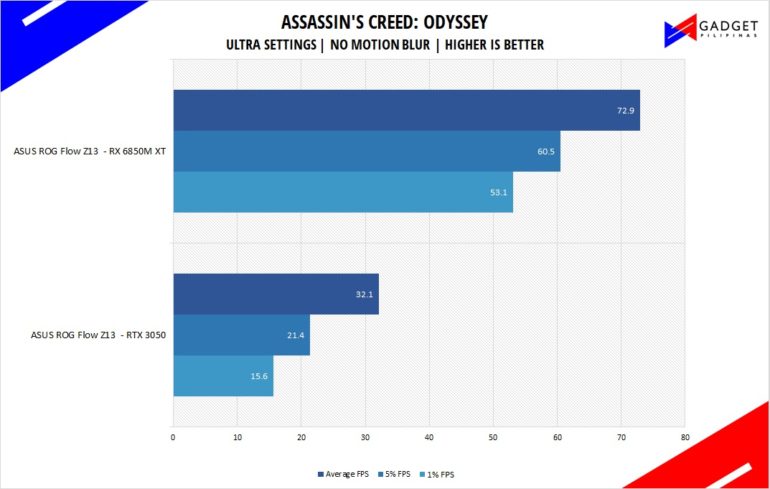
Assassin’s Creed Odyssey is the latest franchise installment from Ubisoft. It’s by far the most popular and stable Assassin’s Creed title since AC IV: Black Flag. It uses the AnvilNext 2.0 game engine, an updated version of Rainbow Six Siege’s game engine, and uses the DirectX 12 API.
F1 2020
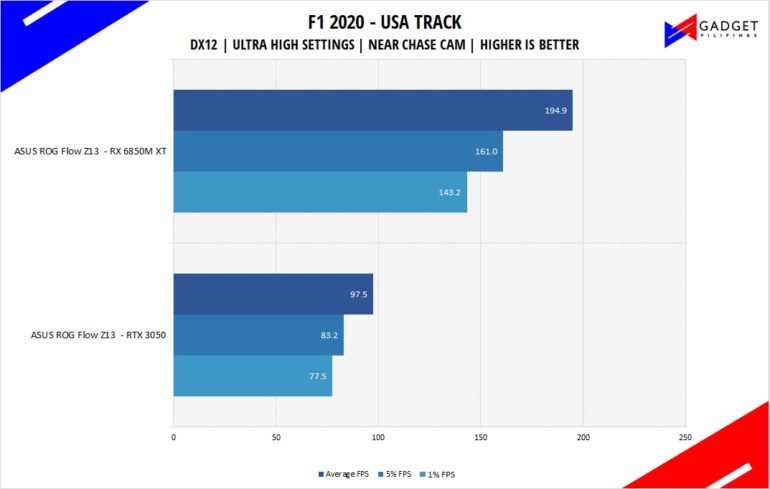
F1 2020 is the official video game of the 2020 Formula 1 and Formula 2 championships developed by Codemasters. F1 2020 is the twelfth installment in the franchise and uses the Ego Engine 3.0. F1 2020 is a good representation of racing games thanks to its realistic graphics and fairly demanding spec requirements.
HORIZON ZERO DAWN
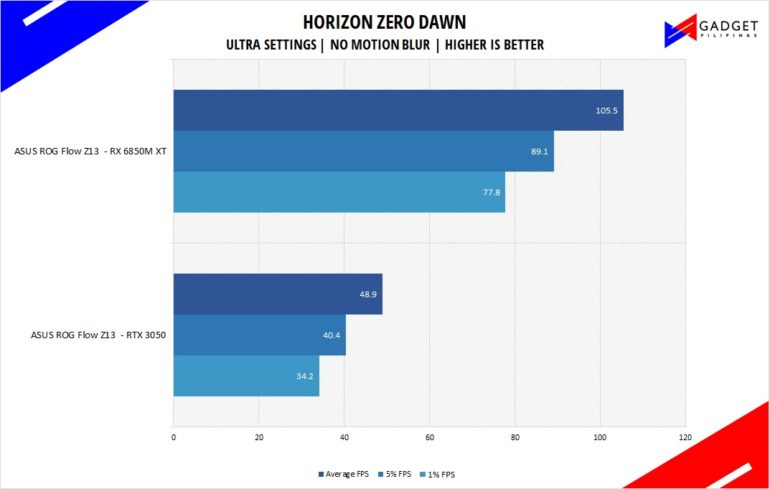
Horizon Zero Dawn is one of the most popular console-port RPG developed by Guerilla Games and published by Sony Interactive Entertainment. Horizon Zero Dawn is a multi-award-winning action RPG, and its popularity resulted in an exclusive Complete Edition game bundle on Steam.
ASUS ROG Flow Z13 Temps
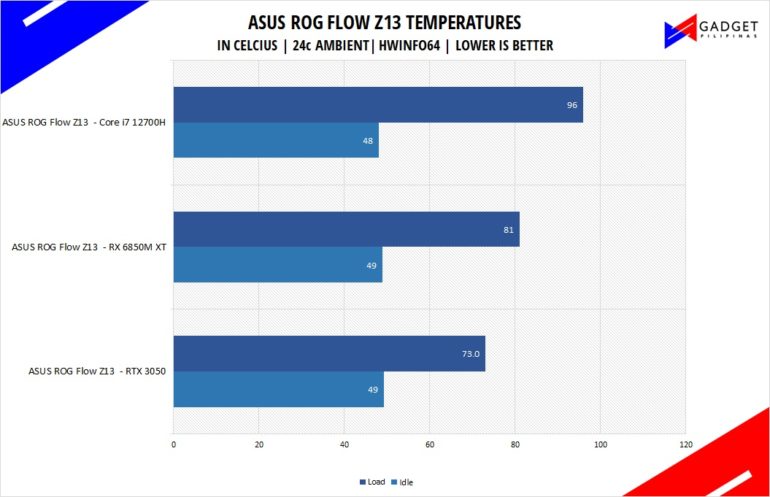
For a thin package, temperatures are impressive overall with the Core i7 12700H only peaking at 96°C even when paired with a 76°C RTX 3050. The 2022 ROG XG Mobile on the other hand recorded a peak temperature of 81°C
Conclusion
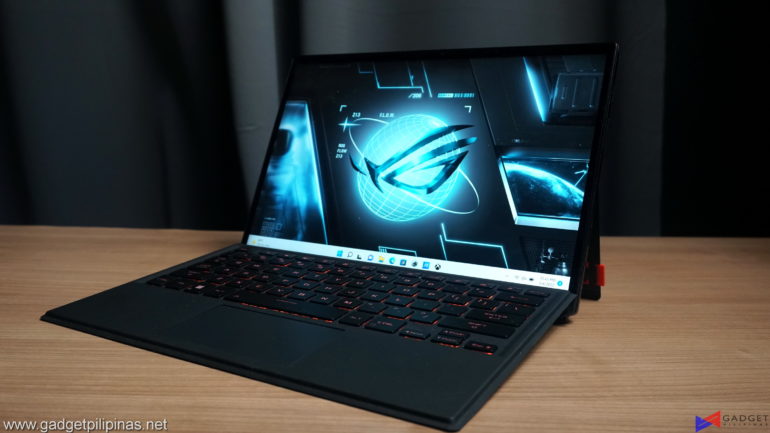
At its price of Php 99,995, the ROG Flow Z13 is definitely an expensive convertible but you’re getting your money’s worth just from its performance thanks to ASUS being able to cram in an H series Core i7 12700H processor and an RTX 3050 graphics card. No, it’s not just there for show as we didn’t expect any thermal throttling even when we’re using the RTX 3050 instead of the 2022 ROG XG Mobile. Compared to a normal Core i7 12700H and RTX 3050 powered laptop, the ROG Flow Z13 packs a punch and is actually a viable alternative as its form factor enables it for productivity and portability – provided you’re willing to pay the premium.
Unfortunately, despite the almost perfect 10 rating in terms of performance, ASUS needs to work out the ROG Flow Z13’s ergonomics as its larger and heavier size makes it uncomfortable during tablet use. The keyboard could use some durability as I feel the whole keyboard deck flexing when I type fast enough. Additionally, there’s no way to store the included pen making it a hassle to takeout and use every time. I would’ve preferred a magnetic snap on the top or use a part of the keyboard to store the pen similar to the Surface Pro type cover.
The ROG Flow Z13 combines portability and power but unfortunately is a jack of all trades but master of none as soon as you take into account its ergonomics. Yes, it’s basically a Surface Pro 8 with steroids for gaming, but taking the issues we’ve mentioned makes it less of a convertible due to the user experience that we had. That said, the ASUS ROG Flow Z13 is still the best of both worlds due to its built-in functionality, but don’t expect anything spectacular when you’re doing a task that’s not taking advantage of the powerful hardware inside the ROG Flow Z13.
That said, the ROG Flow Z13 is something that some gamers need, and it’s something that is currently unparalleled in terms of performance and portability. What makes the ROG Flow Z13 a tempting device is its upgradability via the XG Mobile graphics which has proven to be an effective eGPU solution barring its proprietary XG mobile connect – but it’s also what makes it better than most eGPU solutions. With the now-dated ROG Flow X13. The ROG Flow Z13 offers much more performance, portability, and functionality compared to its predecessor making it a much more viable 13″ gaming device. And if ever you need to upgrade, there’s always the option of choosing either an RTX 3080 or RX 6850M via the ROG XG Mobile. That is if you can afford the Php 69,995 or 89,999 for that graphics card upgrade. It’s also worth noting that the ROG XG Mobile, specifically the XG Connect port will likely stay for much longer and we’re likely to see future releases containing different GPU tiers at different price points to provide the user options for their upgrade later on.
The main question that pops into our mind is whether the ROG Flow Z13 is still worth the purchase without the XG Mobile and the answer is a mixed yes and no because of the available configurations. Without a dedicated GPU or basically the i5 12500H variant, it is imperative that it should be paired with an XG Mobile as you’re just getting a sloppy Surface Pro 8 with RGB and bragging rights without a GPU to power the device. The Core i7 12700H and RTX 3050 on the other hand, are a much better purchase for the reasons mentioned earlier. The RTX 3050 allows you to play most at mixed settings while maximizing its 120Hz display on Esports titles. Plugging in the XG Mobile with the i7 variant makes it a powerful desktop replacement as you can squeeze more frames and performance with a simple upgrade. Overall, the ROG Flow Z13 is a remarkable device built to fuse portability and performance without sacrificing its lifespan thanks to the XG Mobile external graphics. So, if you’re looking for a multipurpose 13″ ultrabook book that packs the same if not better performance than a 15″ laptop, then the ROG Flow Z13 is an irresistible option.
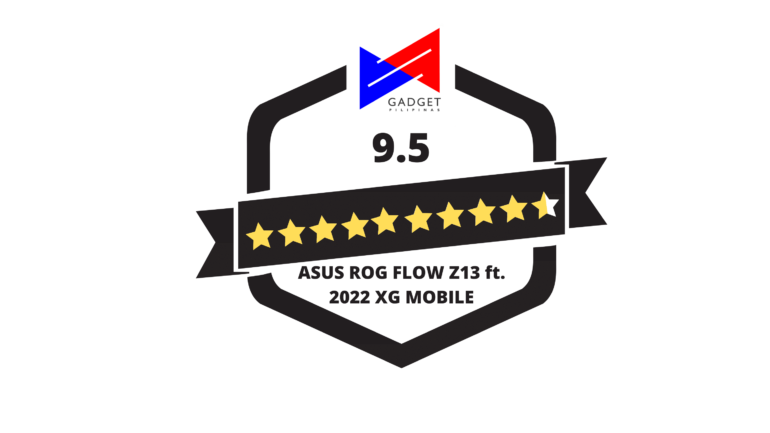
Grant is a Financial Management graduate from UST. His passion for gadgets and tech crossed him over in the industry where he could apply his knowledge as an enthusiast and in-depth analytic skills as a Finance Major. His passion allows him to earn at the same time help Gadget Pilipinas' readers in making smart, value-based decisions and purchases with his reviews and guides.

